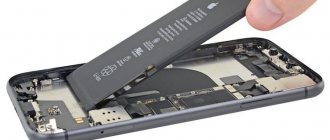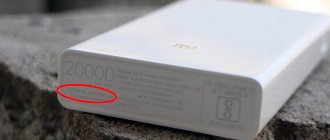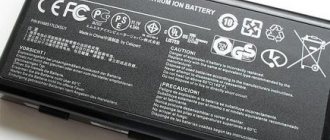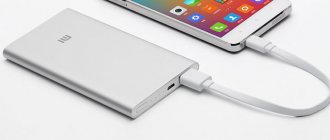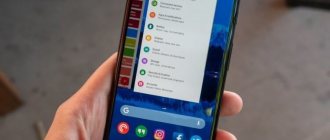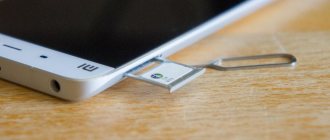There are many tips on how to increase the capacity of a tired battery and normalize the % charge display in the iPhone.
Most often it is advised to calibrate your smartphone in a series of simple steps. I tested the magic technique on myself and I hasten to share the results.
My iPhone 7 played the role of the test subject. The number of its charge and discharge cycles has already exceeded 750. According to Apple’s recommendations, the battery in it needed to be changed 250 charges ago, but it is still working quite well.
Let's calibrate it!
I'm testing the most popular tip for reviving a battery.
To calibrate the iPhone battery, experts recommend using two stages: a preparation stage and a calibration stage.
First you need to disable resource-intensive tasks
✔️ Preparatory stage. At the preparatory stage, you should disable the most energy-consuming processes on your iPhone. This needs to be done so that the smartphone does not turn off at 10-20% charge, and we manage to discharge it to zero.
1. First, you need to turn off automatic content downloads in Settings > iTunes Store & App Store.
2. Next, you should turn off background content updating in the “Settings” > “General” > “Content Update” menu.
3. After this, you need to disable geolocation in the Settings > Privacy > Location Services menu.
4. In the end, it is best to lower the iPhone screen brightness to its minimum setting.
A smartphone with a stale battery may turn off if there is not enough power, so it is better not to overload it.
The easiest way to drain your iPhone is with movies.
✔️ Calibration stage. At the calibration stage, the iPhone needs to be discharged to zero and charged again to the maximum level at least a couple of times. To be safe, I did this 3 times.
▪️ To drain your device to zero, the easiest way is to put the video on repeat in VLC and wait until the smartphone turns off.
After this, it’s better to wait another couple of hours for the internal processes to drain the iPhone to zero - I left the device with video overnight.
▪️ To charge the device to real 100%, you need to connect it to the power supply, wait for the coveted hundred to appear on the indicator, and then wait another couple of hours.
As with draining, I left the iPhone on charge overnight to make sure it was fully charged.
I repeated the charging and discharging procedure exactly three times: on the first night I completely discharged it, on the second I charged it, and so on.
To show the result, experts usually use data from the coconutBattery app.
What's the result?
How do you know when it's time?
Let's look at the signs that indicate that iPhone battery calibration is necessary:
- fast discharge;
Calibration must be done if the iPhone is quickly discharged
- sudden shutdowns at 10–15% charge;
- frozen charge indicator;
- sharp jerks of the indicator;
- you have not discharged your smartphone for more than 3 months.
Wasted my time. Battery performance remains unchanged
The program shows changes, but in reality there are none
Before starting the procedure, I recorded the values in coconutBattery: battery condition is about 83% , maximum capacity is 1631 out of 1960 mAh .
After the procedure, the numbers in the application really increased: the battery condition is about 88% , the maximum capacity is 1724 out of 1960 mAh .
It would seem that it’s time to clap your hands and run to write the most positive conclusions.
But instead, I started observing the data that coconutBattery produces for a couple of minutes.
The miracle application surprised me: the percentage of the battery status jumped to different values in the range of 80-90%. Therefore, there can be no talk of any accuracy in this case.
Instead, I will use a more realistic source of information that you can trust - “Battery Health” from the “Settings” > “Battery” menu:
And it was and remains 87%.
The maximum battery capacity is 87%, it was this way before the experiment and remained the same after it.
This confirms two facts:
▪️ There is no point in calibrating the iPhone battery - we will see this a couple more times later. ▪️ Third-party apps do not have access to real iPhone battery health data.
If you are not satisfied with the battery life of your iPhone, and the number of recharge cycles has exceeded 500, change the battery
Face it, this is a consumable, and it gradually breaks down every second.
How to calibrate the iPhone battery and why is it needed?
Hi all! The iPhone has a lithium-ion battery, and such batteries are not known to have a memory effect. Then why do you need to calibrate them at all? The fact is that the battery capacity decreases over time (how to check its current condition) and if you have had the phone for a long time, then in the absence of battery calibration, strange things begin...
What happens is that the iPhone “does not understand” what the current battery capacity is and cannot correctly provide information about the battery charge level. As a result, various non-standard situations occur: an unexpected shutdown of 20-30%, the charging indicator freezing (displaying one value for a long time), incorrect data about how charged the iPhone is and other outrages.
By the way, although in this article I write everywhere about the iPhone, this method of calibrating the battery is also great for other Apple equipment: iPad and iPod.
But first, let's summarize the signs that clearly indicate that it's time to calibrate your iPhone battery.
Here they are:
- The iPhone turns off while there is still some charge remaining. It would seem that he still has to work and work, but bam he switches off.
- In some cases, calibration will help those users whose battery runs out very quickly. True, this is just one of the methods of dealing with a smartphone that instantly discharges.
- If the iPhone freezes at one percent of charge for a long time, and then the indicator suddenly “jumps” by several tens of percent.
- Once every 2-3 months, it is advisable to perform calibration for absolutely all iPhone and iPad users. If you've never done it before, now is the time!
Is at least one of the described cases your situation?
Then read on and learn how to properly calibrate your iPhone battery!
5 simple steps:
- Wait until the device is completely discharged. Precisely completely and completely (absolutely, “to zero”, so as not to be included at all).
- We put it on charge (preferably from the mains) and don’t touch it (of course, you can answer an urgent call, but you don’t need to play or use it). We wait until it charges to 100%.
- Leave it connected for another hour or two. For what? For reliability! After all, our iPhone shows charging incorrectly? Wrong! Which means you can’t trust him. And despite the fact that the screen displays 100% charge, the battery may not be fully charged! Therefore, to be sure, after reaching 100%, we do not unplug it immediately, but wait at least another hour.
- Disconnect from the network and do a hard reboot. To do this, press and hold two keys - Home and Power - until the apple icon lights up on the screen. Updated! This button combination does not work for all devices. How to be? Here are detailed instructions about Hard Reset any iPhone!
- We use the device until it is completely discharged.
- We repeat this procedure 2-3 times.
As you can see, there is nothing super complicated. And the only “narrow” point is time.
But there’s nothing you can do about it; battery calibration is not a quick thing.
Important! When you start doing the second round, you don’t need to briefly charge your iPhone! The circuit should be exactly like this - from 100% to 0%, then fully charged without a break, charged, hard reset and discharged to 0% without recharging.
Only in this case will the calibration be done truly correctly and will benefit your iPhone battery.
PS Write about your results in the comments, be sure to ask questions and like. After all, every “+1” on social network icons increases the battery life of your device. I think it's worth a try! :)
iPhone battery controllers keep track of them reliably
How the controller controls iPhone charging
iPhone perfectly controls the charging of its battery, which takes place in two stages: fast charging and trickle charging.
▪️ Fast charging. First, the iPhone loads its battery as much as possible and brings the energy inside it to 80%.
This charging time depends on the power source you are using: a standard power supply, an iPad power supply, Power Delivery mode with a MacBook power supply and a Lightning to USB-C cable.
At the same time, the controller monitors the temperature and reduces the charging speed if it reaches critical values.
▪️ Compensatory charging mode. The remaining 20% of the battery is charged at a reduced current, and the energy level inside it gradually reaches 100%.
This is necessary so that the battery wears out as little as possible. Therefore, even my iPhone 7 with 750 recharge cycles today feels quite normal and even shows “Peak Performance” of the battery.
Causes of the problem
In order not to delve too deeply into chemistry and electronics, we will only note that the lithium-ion batteries that are included in Apple devices change their ability to hold a charge for the worse over time. The internal controller does not comply with the changes and calculates the remaining energy in the old way, so every two to three months each Apple user must calibrate the battery.
Periodic calibration has a beneficial effect on the battery's ability to hold a charge. The charge indicator also returns to normal and shows adequate readings of the remaining energy in the battery, corresponding to reality.
Apple itself doesn't even recommend calibration.
Battery controllers are calibrated during production
In the past, Apple actually advised periodic calibration of the batteries of its devices. Most likely, this concept has remained in the minds of experts since then.
However, this never had anything to do with the iPhone. Controllers for devices with a built-in battery are calibrated during production and do not require any additional manipulations.
Only devices with a removable battery need to be calibrated: MacBook and MacBook Pro before 2009, as well as iBook and PowerBook.
Why is this necessary?
Unlike outdated nickel-cadmium and nickel-magnesium batteries, lithium-polymer batteries are not subject to the memory effect, and you can charge them as you please.
However, periodically such batteries can and even need to be calibrated. This applies to a greater extent to older devices with worn-out batteries. Calibration will help the smartphone correctly display the charge level, and will also slightly increase the maximum capacity and extend battery life.
How much is a separate question, which we will answer at the end of the article. To be honest, I was quite skeptical, but looking ahead, I will say that it was in vain.
When to change the battery in your favorite iPhone
500 cycles is not always the limit
Apple recommends replacing the battery after 500 charge cycles . During this time, its condition usually falls below 80%, and then the rate of its degradation increases exponentially.
But I have in my hands a vivid example of a relatively careful attitude towards the device: an iPhone 7 with 750 charging cycles and a battery condition of 87%.
I don’t do anything supernatural, but I hardly break the 5 rules above in the text.
Don't overcool your iPhone
Cold is also harmful to the iPhone battery. At temperatures of 0 °C and below, reactions in a lithium-ion battery begin to slow down, which also reduces the battery capacity.
With winter quickly approaching, this advice will be most relevant over the next few months ( more tips on using your iPhone in winter ). Try not to use your iPhone outside in cold weather. And we are not talking about severe frosts here, but even the slightest ones, when the temperature may seem quite comfortable to you personally. This is not the case for a battery.
Yes, limiting yourself to your usual iPhone use can be uncomfortable. But thanks to this, the smartphone battery will definitely last much longer.
